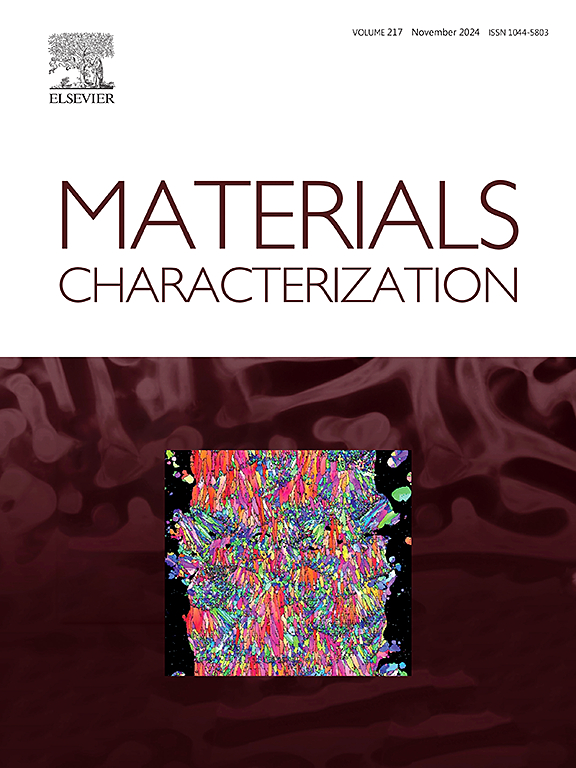Improvement of superelasticity by controlling NiAl precipitates in polycrystalline Fe-Ni-Co-Al-based alloy
IF 4.8
2区 材料科学
Q1 MATERIALS SCIENCE, CHARACTERIZATION & TESTING
引用次数: 0
Abstract
The superelastic effect (SE) in polycrystalline Fe-Ni-Co-Al-based alloys primarily arises from the growth and recovery of thermoelastic martensite. The martensitic transformation process is influenced by intragranular Ni3Al nanoprecipitates and NiAl precipitates along grain boundaries. Highly coherent Ni3Al plays a significant role in elastic accommodation during transformation process, whereas NiAl impedes the recovery of martensite. Low-energy grain boundaries (LEGBs) inhibit the nucleation of NiAl, and the greater the texture strength, the less likely for NiAl to accumulate at grain boundaries. This paper utilizes two methods to control the proportion and texture of LEGBs: cold rolling after hot rolling followed by rotary cold rolling (CT + RCR), and direct rotary cold rolling after hot rolling (RCR). The results show that the CT + RCR sample produces a RD∥〈100〉 texture, while the RCR sample obtains a {203}〈100〉 texture with a higher strength. The proportions of LEGBs for the CT + RCR and RCR are 24.8 % and 43.6 %, respectively. In the CT + RCR, the coarse NiAl precipitates at high-angle grain boundaries (HAGBs) restrict the recovery of most martensites, resulting in a SE of only 0.6 %. In the RCR, NiAl precipitates at HAGBs are smaller than those in the CT + RCR. Due to the combination of favorable texture orientation and a higher proportion of LEGBs, a large amount of stress-induced martensite can grow and recover during cyclic loading and unloading, achieving a 6 % SE.
控制NiAl析出提高多晶fe - ni - co - al基合金的超弹性
多晶fe - ni - co - al基合金的超弹性效应主要来源于热弹性马氏体的生长和恢复。晶粒内Ni3Al纳米相和沿晶界NiAl相影响马氏体相变过程。在相变过程中,高共聚Ni3Al在弹性调节中起重要作用,而NiAl则阻碍马氏体的恢复。低能晶界抑制NiAl的形核,织构强度越大,NiAl越不容易在晶界聚集。本文采用热轧后冷轧再旋转冷轧(CT + RCR)和热轧后直接旋转冷轧(RCR)两种方法来控制legb的比例和织构。结果表明:CT + RCR试样产生的织构为RD∥< 100 >,RCR试样得到的织构为{203}< 100 >,且强度更高;LEGBs占CT + RCR和RCR的比例分别为24.8%和43.6%。在CT + RCR中,高角度晶界(HAGBs)处的粗NiAl相限制了大多数马氏体的恢复,导致SE仅为0.6%。在RCR中,HAGBs的NiAl析出物比CT + RCR少。由于良好的织构取向和较高比例的legb的结合,在循环加载和卸载过程中,大量应力诱导马氏体可以生长和恢复,达到6%的SE。
本文章由计算机程序翻译,如有差异,请以英文原文为准。
求助全文
约1分钟内获得全文
求助全文
来源期刊

Materials Characterization
工程技术-材料科学:表征与测试
CiteScore
7.60
自引率
8.50%
发文量
746
审稿时长
36 days
期刊介绍:
Materials Characterization features original articles and state-of-the-art reviews on theoretical and practical aspects of the structure and behaviour of materials.
The Journal focuses on all characterization techniques, including all forms of microscopy (light, electron, acoustic, etc.,) and analysis (especially microanalysis and surface analytical techniques). Developments in both this wide range of techniques and their application to the quantification of the microstructure of materials are essential facets of the Journal.
The Journal provides the Materials Scientist/Engineer with up-to-date information on many types of materials with an underlying theme of explaining the behavior of materials using novel approaches. Materials covered by the journal include:
Metals & Alloys
Ceramics
Nanomaterials
Biomedical materials
Optical materials
Composites
Natural Materials.
 求助内容:
求助内容: 应助结果提醒方式:
应助结果提醒方式:


